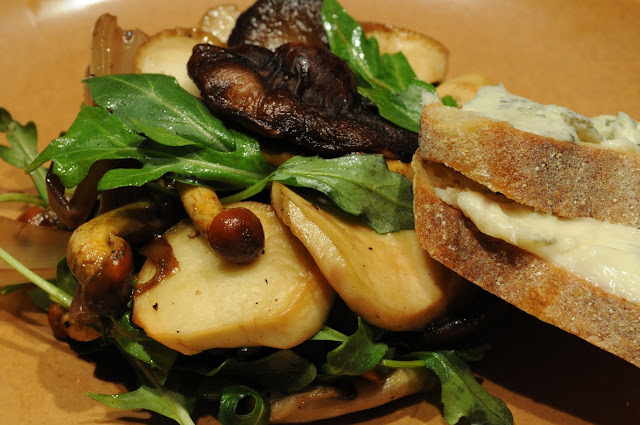 |
| A selection of exotic west Quebec mushrooms from Le Coprin. The greater the selection the more complex the flavour. My favourites are the honey and king eryngii. |
Oddly enough I developed this recipe the first week of January. I was thinking about a cold weather salad and was tried of beets, one of my fall back ingredients for cold weather salads. I was researching warm “salads” for cold days and I saw something like this. It was the idea of mushrooms that caught my imagination, but the original recipe used capers which reminded me of the jars of Ivan’s wild ramps, all picked on the Ontario side of the Ottawa River, that I had pickled last spring. I make a relish with them and thought that I could adopt them for this recipe.
The next thing of course was the mushrooms. Christophe Marinaux cultivates mushrooms up the Gatineaux, on a farm near Wakefield. He picks as well, however, the demand for the cultivated mushrooms and the demand of family limits his picking. I am always happy if he comes in with wild chanterelles or even more special, Gatineaux hills porcini. However, for this recipe, I am using a variety of his Asian mushrooms, particularly varieties of oyster and shitake mushrooms that he produces. The more interesting the mushroom, the more interesting the salad. Make time and take the effort to locate some interesting mushrooms.
The half dried tomatoes are from Italy and I prefer them to the dried tomato because they are have more pulp and are juicier. They are harder to find and if you can’t find them, use the oil packed dried tomato cut in thin slivers. I love olives and thought that their brininess and saltiness would work well with the sweetness of the tomatoes, the pickle of the ramp and meatiness of the mushroom. The arugula adds a contrast to the salad and wilts well; you don’t want it to wilt all the way, just soften it with the warm oil.
The garlic bread is wonderful. Normally I use Romano cheese – I prefer the sharp taste of the Romano, but if you prefer a more subtle flavour use Parmesan – but for this recipe I have substituted Highland Blue. Back Forty’s cheese production is spotty and their cheeses aren’t always available. If you can’t find it, use Roquefort, or maybe just go with the Romano. If you think that you are making too mush base, you aren’t. It keeps well in the refrigerator for about three weeks, but it never lasts that long in my house. In the old days it lasted even less time in the restaurant.
Use this salad as a starter to a diner or make a larger salad and serve it for a lunch entrée. Enjoy.
Warm Cermini, Exotic West Quebec Mushroom, Half Dried Tomato,
House Preserved Ottawa Valley Wild Ramp, and Olive Salad
with Back Forty Highland Blue-garlic bread,
a balsamic-lemon drizzle and arugula
for the salad:
6 Tbsp. olive oil ½ lb. cermini mushroom
12 oz. west Quebec mushrooms ¼ cup pickled wild ramp
¼ cup black olives 2 Tbsp. lemon
2 Tbsp. balsamic vinegar salt and pepper to taste
Remove the stems from the cermini and cut caps into slices or leave whole if small; cut the west Quebec mushrooms into appropriate size. Cut the ramps into quarters along their length. Toss the mushroom with the oil, sauté in small batches until browned. Combine the mushrooms, ramps, olives, lemon juice and balsamic vinegar in a roasting pan. Roast in a 400° for about 10-12 minutes, to bring the flavours together. Set aside.
Per order warm a half-cup of the mushroom mixture; at the same time, toss the arugula with olive oil. When still warm, toss the mushrooms with the arugula to lightly wilt.
for the bread:
½ lb. butter at room temperature ½ cup extra virgin olive oil
½ cup roasted garlic ½ cup blue cheese
salt and pepper to taste
Whisk all the ingredients together. Brush the bread with the mixture and toast in oven for 2-3 minutes.
 |
| The finished salad. Warm, with complex flavours and a satisfying ending. |









